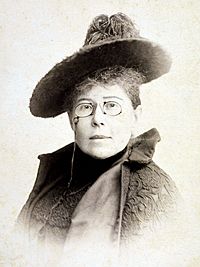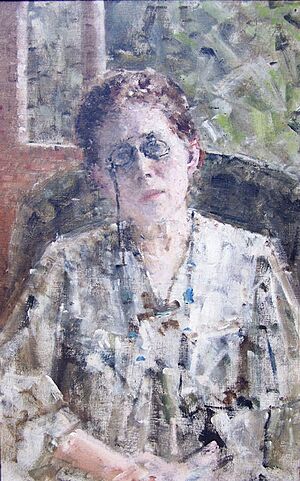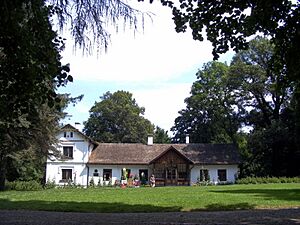Maria Konopnicka facts for kids
Quick facts for kids
Maria Konopnicka
|
|
|---|---|

Konopnicka in 1897
|
|
| Born | Maria Wasiłowska 23 May 1842 Suwałki, Augustów Governorate, Congress Poland, Russian Empire |
| Died | 8 October 1910 (aged 68) Lwów, Kingdom of Galicia and Lodomeria, Austria-Hungary |
| Pen name |
|
| Occupation | Writer, poet |
| Nationality | Polish |
| Genre | Realism |
| Notable works | Rota |
| Signature | |
Maria Konopnicka (born Wasiłowska; 23 May 1842 – 8 October 1910) was a famous Polish writer. She was a poet, novelist, and wrote many books for children. Maria also worked as a translator, journalist, and critic. She was a strong voice for women's rights and for Poland's independence. She sometimes used pen names, like Jan Sawa. She is known as one of the most important poets from Poland's Positivist period.
Contents
About Maria Konopnicka's Life

Maria Konopnicka was born in Suwałki, Poland, on 23 May 1842. Her father, Józef Wasiłowski, was a lawyer. Maria was taught at home when she was young. She also spent a year at a convent school in Warsaw.
She started her writing career in 1870. Her first published poem was called "W zimowy poranek" ("On a Winter's Morn"). She became very popular after her poem "W górach" ("In the Mountains") was published in 1876. A famous writer, Henryk Sienkiewicz, who later won a Nobel Prize, praised her work.
In 1862, Maria married Jarosław Konopnicki. They had six children together. In 1878, she moved to Warsaw with her children. She wanted to focus on her writing career. Maria often traveled around Europe. Her first big trip was to Italy in 1883. She lived abroad in Europe for many years, from 1890 to 1903.

Maria was a good friend of another Polish writer, Eliza Orzeszkowa. She was also close friends with the painter and activist Maria Dulębianka. Maria Konopnicka was active in social causes. She protested against unfair treatment of Polish people and other groups in Prussia. She also worked hard for women's rights.
Her writings became very well-known in Poland during the 1880s. In 1884, she started writing books for children. In 1888, she published her first stories for adults, called Cztery nowele (Four Short Stories). Because her writings were so popular, Polish activists decided to buy her a home in 1902. They raised money from many groups to buy her a manor house.
Poland was not an independent country at that time. Maria's writings often had strong political messages. So, they chose a place in the Austrian part of Poland, which was more accepting. In 1903, she received a manor in Żarnowiec. She spent most springs and summers there. However, she still traveled around Europe in the fall and winter.
Maria Konopnicka passed away in Lwów (now Lviv, Ukraine) on 8 October 1910. She was buried in the Łyczakowski Cemetery. Her friend Maria Dulębianka was buried next to her, as Maria Konopnicka had wished.
Maria Konopnicka's Written Works

Maria Konopnicka wrote both prose (like short stories) and poems. She often wrote poems that sounded like folk songs. She explored many different types of writing. These included reports, memories, and character studies.
A common topic in her works was the difficulties faced by farmers, workers, and Polish Jews. Her writings also showed strong love for her country. She was known for her sympathy towards Jewish people.
One of her most famous works is a long poem called Mister Balcer in Brazil (Pan Balcer w Brazylii). It was published in 1910. This poem tells the story of Polish people who moved to Brazil. Another very important work is Rota (Oath), from 1908. This poem was set to music two years later. It became an unofficial national song for Poland, especially in areas controlled by Prussia. This patriotic poem strongly criticized German policies.
Her most well-known book for children is O krasnoludkach i sierotce Marysi (Little Orphan Mary and the Gnomes), published in 1896. Her children's books were very popular and well-liked.
Maria Konopnicka was also a translator. She translated works by other authors into Polish. For example, she translated Fatalita and Tempeste by Ada Negri. These were published in Poland in 1901.
Honoring Maria Konopnicka
- In 1922, a special education school in Pabianice was named after her.
- Her manor house in Żarnowiec became a museum in 1957. It is called the Maria Konopnicka Museum in Żarnowiec. Another museum dedicated to her opened in Suwałki in 1973.
- Many schools, streets, and squares in Poland are named after Maria Konopnicka. A Polish Merchant Navy ship, MS Maria Konopnicka, was also named for her.
- Several statues and plaques have been built to honor her. A monument was built in Suwałki in 2010.
- In 1994, a crater on the planet Venus was named after her.
- In 2010, on the 100th anniversary of her death, the International Maria Konopnicka Prize was created in Warsaw. This award recognizes important social work.
- Selected monuments and memorials dedicated to Maria Konopnicka:
-
Statue in Suwałki
-
Statue in Bydgoszcz
-
Statue in Kalisz
-
Statue in Gdańsk
Selected Works by Maria Konopnicka
Poetry Collections
- Linie i dźwięki (Lines and Sounds, 1897)
- Śpiewnik historyczny (Historical Music Book, 1904)
- Głosy ciszy (Sounds of Silence, 1906)
- Z liryk i obrazków (Lyrics and Pictures, 1909)
- Pan Balcer w Brazylii (Mister Balcer in Brazil, 1910)
Prose Works
- Cztery nowele (Four Short Stories, 1888)
- Moi znajomi (People I Know, 1890)
- Na drodze (On the Way, 1893)
- Ludzie i rzeczy (People and Things, 1898)
- Mendel Gdański
Children's Books
- Śpiewnik dla dzieci (Songbook for Children)
- O Janku Wędrowniczku (About Johnnie the Wanderer)
- O krasnoludkach i sierotce Marysi (About the Dwarfs and Little Orphan Mary)
- Na jagody (Picking Blueberries)
Famous Poems
- Rota (Oath, 1908)
- Stefek Burczymucha
- Wolny najmita (The Free Day-Labourer)
See also
 In Spanish: Maria Konopnicka para niños
In Spanish: Maria Konopnicka para niños









